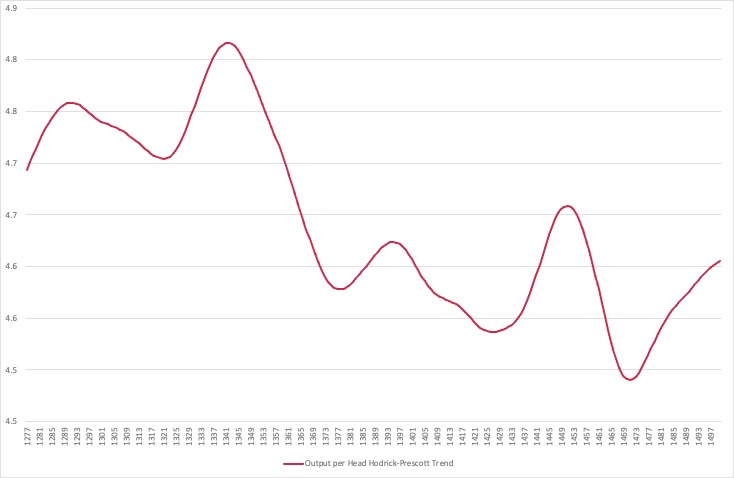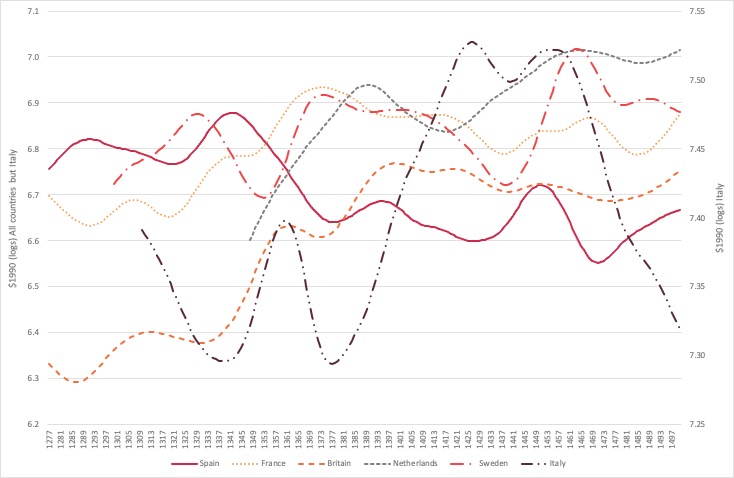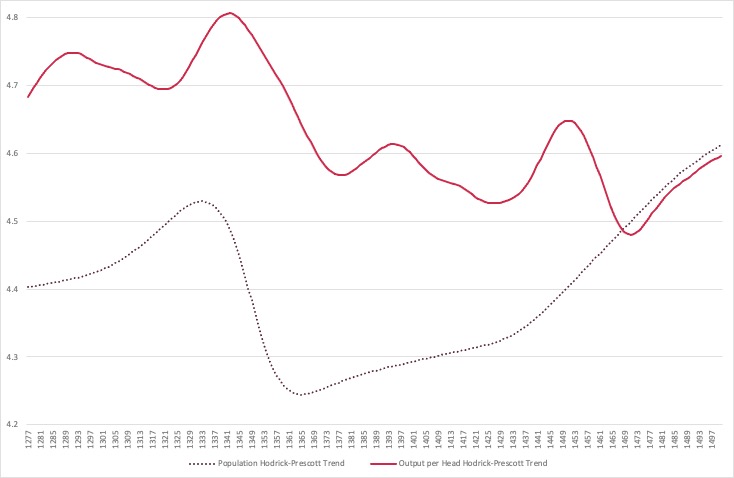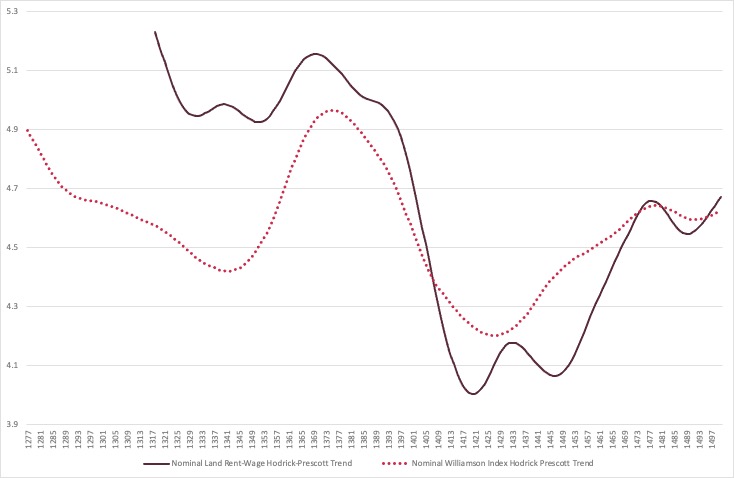The Black Death in Spain: A European Perspective

The Black Death in Spain: A European Perspective
Thursday 17 Dec 2020For many European countries, the aftermath of the Black Death in the fourteenth century saw an increase in average income and a reduction in income inequality. As labour became more scarce, the bargaining power of workers rose and so did their wages. But this was not the case in Spain. Here, incomes fell and inequality rose. Carlos Álvarez- Nogal, Leandro Prados de la Escosura and Carlos Santiago-Caballero investigate why Spain fared so differently to its neighbours. Their findings suggest that the economic effects of a pandemic depend a great deal on the economic conditions of a country before the pandemic began.
The dramatic effects of COVID-19 have created an interest in the economic consequences of pandemics in history. Recent literature points out the effects not only on average incomes but also on their distribution. Guido Alfani (2021) for example, suggests that the Black Death produced a reduction of income inequality in Italy. The explanation follows Malthusian theory, which assumes that wages are closely linked to population size. After the demographic catastrophe that followed the arrival of the Black Death, average incomes for those who survived increased and inequality declined as labourers’ bargaining power improved.
However, although this seems to be the general rule in most of Europe, there were also important exceptions. In the territories of today’s Spain average incomes fell and inequality rose.
As Figure 1 shows, in the case of Spain the Black Death produced a sharp contraction in income per head. The fall was so intense that the levels reached on the eve of the Black Death (1348) did not recover until the nineteenth century (Prados de la Escosura et al., 2020).
Figure 1. Real GDP per Head, 1277-1500 (Hodrick-Prescott Trend)

Source: Prados de la Escosura et al. (2020)
This was not the case in the main European economies. Average incomes increased after the Black Death in Britain, France, Italy and the Netherlands. In Sweden, incomes did not recover immediately after the plague and when they did, the increase was moderate (Figure 2). Why was Spain, and to some extent Sweden, different?
Figure 2. Hodrick-Prescott Trends in Real GDP per Head in European countries, 1277-1500

Sources: Álvarez-Nogal et al. (2020)
Note: To facilitate the comparison, Italy’s higher GDP per head is represented on the right hand scale.
If Malthusian pressures (large populations and low wages) were to blame for the high inequality and low average incomes for most of Europe before the arrival of the plague, then their absence in Spain could suggest an explanation. Figure 3 shows that population and income per head followed similar trends in Spain before and after the Black Death, exactly the opposite relationship one would expect in a Malthusian economy where increases in population lead to a reduction in average income per head and vice versa.
Figure 3. Hodrick-Prescott Trends in Spain’s GDP per Head and Population, 1277-1500
 \
\
Source: Prados de la Escosura et al. (2020)
Additional support for this hypothesis results from analysing the impact of the Black Death on income distribution. Figure 4 presents the nominal land rent – wage ratio and the Williamson Index for Spain; two methods of measuring income inequality. The first measure’s rationale is that land is less evenly distributed than labour and also captures the returns of the proprietors, while wages capture the returns of those less privileged. The Williamson index is expressed as the ratio between nominal output per capita and nominal wage rates, on the assumption that while wages capture the returns of those in the lower part of the distribution, output per capita captures the average returns. As constructed, increases of both measures imply an increase in income inequality and vice versa.
Figure 4. Nominal Williamson Index and Land Rent-Wage Ratio, 1277-1500

Source: Prados de la Escosura et al. (2020)
Figure 4 shows that, unlike in Italy, in Spain the Black Death provoked an increase in income inequality. This finding lends support to the idea that Spain was not a territory subjected to Malthusian pressures. Its population density was low (8.9 and 7.8 inhabitants per square kilometre in 1300 and 1400, respectively, compared to 41.5 and 26.6 in Italy and 29.8 and 17.9 in England and Wales), while its urbanisation rates were among the highest in Europe (8.1 and 7.6% in 1300 and 1400 respectively, as opposed to 4.0 and 2.5% in England and Wales but still below Italy’s, 18.0 and 12.4%). But what explains the sharp decrease in income per head after the Black Death?
We believe the explanation lies in the existence of a frontier economy, and a literal frontier existed during the Reconquista. The instability at the borders between Christian and Muslim kingdoms and the high land-labour ratio created incentives for the development of a pastoral economy, intensive in the use of land and scarce in the use of labour. At the same time, the existence of a vibrant urban network connected primary producers through a system of fairs that were also linked to international markets. This process, advanced by MacKay (1977), would explain why average income levels in Spain before the Black Death were well above subsistence. In this context, population expansion would have had increasing economic returns and the shock created by the pandemic produced a devastating blow to an efficient but fragile economy.
To sum up, the case of Spain reflects that the economic effects of a devastating pandemic largely depend on the initial conditions of a society. Fourteenth century Spain was able to adapt its economy to the availability of inputs, where the abundance of land and scarcity of labour combined by an efficient trade network made possible the highest income levels for nearly five hundred years. However, from representing its biggest strength, labour scarcity became the major weakness of the Spanish economy with the arrival of the Black Death. Indeed, this could explain why although Spain suffered a lower population loss than most of Europe, its economy was one of the most severely damaged.
Carlos Álvarez- Nogal, Universidad Carlos III de Madrid
Leandro Prados de la Escosura, Universidad Carlos III de Madrid and CAGE
Carlos Santiago-Caballero, Universidad Carlos III de Madrid
References
Alfani, G. (2021), Economic inequality in preindustrial times: Europe and beyond. Journal of Economic Literature, 59(1), forthcoming.
Alvarez-Nogal, C., Prados de la Escosura, L. and Santiago-Caballero, C. (2020), Economic Effects of the Black Death: Spain in European PerspectiveLink opens in a new window. Investigaciones de Historia Económica / Economic History Research, 16(4), pp. 35-48. (Open access)
MacKay, A. (1977), Spain in the Middle Ages. From Frontier to Empire, 1000-1500. Palgrave Macmillan, London.
Prados de la Escosura, L., Alvarez-Nogal, C. and Santiago-Caballero, C. (2020), Growth Recurring in Preindustrial Spain: Half A Millennium Perspective. CEPR Discussion Paper DP14479.
